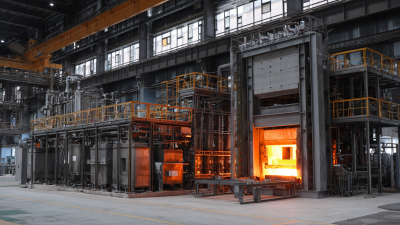7 Best Practices for Cladding Hot Isostatic Pressing Success
 Cladding Hot Isostatic Pressing (CHIP) has emerged as a transformative technique in advanced manufacturing, particularly within aerospace and medical industries, where material integrity and strength are paramount. According to a report by Market Research Future, the global market for hot isostatic pressing is projected to grow significantly, reaching approximately $1.5 billion by 2025, owing to its ability to enhance material properties and reduce porosity. This method utilizes high pressure and temperature to unify dissimilar materials, leading to superior performance characteristics. However, achieving successful outcomes with CHIP necessitates adherence to best practices that ensure optimal processing conditions and material compatibility.
In this blog, we will delve into seven essential best practices that can pave the way for successful Cladding Hot Isostatic Pressing, helping professionals to navigate the complexities of this innovative process effectively.
Cladding Hot Isostatic Pressing (CHIP) has emerged as a transformative technique in advanced manufacturing, particularly within aerospace and medical industries, where material integrity and strength are paramount. According to a report by Market Research Future, the global market for hot isostatic pressing is projected to grow significantly, reaching approximately $1.5 billion by 2025, owing to its ability to enhance material properties and reduce porosity. This method utilizes high pressure and temperature to unify dissimilar materials, leading to superior performance characteristics. However, achieving successful outcomes with CHIP necessitates adherence to best practices that ensure optimal processing conditions and material compatibility.
In this blog, we will delve into seven essential best practices that can pave the way for successful Cladding Hot Isostatic Pressing, helping professionals to navigate the complexities of this innovative process effectively.
Understanding Hot Isostatic Pressing and Its Importance
Hot Isostatic Pressing (HIP) is a crucial process in materials engineering, known for enhancing the mechanical properties of metals and ceramics. It involves applying high temperature and pressure uniformly from all directions, allowing for the elimination of porosity and leading to denser and stronger materials. This technique is vital for industries requiring high-performance components, such as aerospace, automotive, and medical fields. Understanding HIP's nuances can significantly improve product quality and durability.
When implementing HIP, one should prioritize equipment maintenance to ensure optimal performance. Regular inspections and timely repairs can prevent costly downtimes and failures during pressing cycles. Additionally, proper material selection is essential; not every metal or ceramic responds equally to HIP. It’s advisable to conduct preliminary tests on candidate materials for compatibility with the HIP process.
Incorporating process monitoring systems can also elevate the quality of the final product. By tracking temperature and pressure in real-time, manufacturers can tightly control the conditions during pressing, leading to more consistent outcomes. Training personnel on these technologies and best practices further strengthens the overall HIP process, ensuring long-term success in achieving desired material properties.
Key Factors for Selecting the Right Cladding Materials
When it comes to hot isostatic pressing (HIP), selecting the right cladding materials is crucial for achieving desired mechanical properties and optimal performance. Firstly, understanding the compatibility of the cladding material with the substrate is fundamental.
 Materials with similar thermal expansion coefficients can reduce the risk of delamination during the HIP process. This ensures that the cladding adheres properly and maintains integrity under high pressure and temperature conditions.
Materials with similar thermal expansion coefficients can reduce the risk of delamination during the HIP process. This ensures that the cladding adheres properly and maintains integrity under high pressure and temperature conditions.
Another key factor to consider is the corrosion resistance of the cladding material. Industries such as aerospace and oil and gas often operate in harsh environments where exposure to corrosive agents is a concern. Choosing cladding materials that exhibit excellent corrosion resistance can significantly enhance the lifespan of the final product.
Furthermore, evaluating the mechanical properties of potential cladding materials—such as tensile strength and ductility—can help ensure that the final part meets performance requirements while minimizing the risk of failure in service.
Maximizing Process Efficiency: Tips for Optimal Pressing Conditions
Hot Isostatic Pressing (HIP) is a critical process in the manufacturing of high-performance materials, particularly in industries like aerospace and biomedical engineering. Maximizing process efficiency is vital for achieving desirable material properties while minimizing costs. According to a report by the International Journal of Advanced Manufacturing Technology, optimizing pressing conditions can improve yield by up to 30%, significantly impacting the overall production cycle time.
To attain optimal pressing conditions, it's essential to focus on key parameters such as temperature, pressure, and time. A study published in the Journal of Materials Processing Technology indicates that maintaining a uniform temperature distribution within the chamber can enhance the densification of powders, leading to a reduction in material porosity by as much as 50%. Furthermore, adjusting the pressure cycle can prevent common defects encountered during the HIP process. Implementing real-time monitoring systems allows manufacturers to adaptively respond to fluctuations, promoting consistent outcomes and high-quality results.
Utilizing predictive modeling tools can also guide the process settings to align with specific material behaviors. Research from the Materials Research Society highlights that leveraging simulation software in the HIP process leads to a reduction in trial-and-error attempts by 40%, thus expediting the development of new materials. With these strategies, companies can not only optimize their pressing conditions but also position themselves as leaders in the competitive material manufacturing landscape.
7 Best Practices for Cladding Hot Isostatic Pressing Success
This chart illustrates the optimal pressing conditions based on various factors affecting process efficiency in Hot Isostatic Pressing (HIP).
Common Pitfalls to Avoid in Hot Isostatic Pressing
When it comes to Hot Isostatic Pressing (HIP), understanding common pitfalls can significantly enhance the likelihood of a successful outcome. One of the most frequent mistakes is inadequate material preparation. Without proper cleaning and surface treatment, contaminants can interfere with the sintering process, leading to suboptimal density and mechanical properties. Therefore, ensuring that the materials are free from grease, oxide layers, and other impurities is crucial for achieving the desired results.
Another common issue arises from improper temperature and pressure settings during the HIP process. It's vital to adhere to the specified parameters for each material; deviations can lead to poor densification or even material failure. Many operators underestimate the importance of a controlled heating rate, which can negatively affect the microstructure of the final product. Continuous monitoring and adjustment of these parameters based on real-time insights can help mitigate these risks and ensure that the HIP process operates smoothly.
7 Best Practices for Cladding Hot Isostatic Pressing Success - Common Pitfalls to Avoid in Hot Isostatic Pressing
| Best Practice | Description | Common Pitfall | Avoidance Strategy |
|---|---|---|---|
| Material Selection | Choose appropriate materials for cladding. | Using incompatible materials. | Conduct thorough material compatibility tests. |
| Processing Parameters | Optimize temperature and pressure settings. | Neglecting parameter adjustments. | Regularly monitor and calibrate equipment. |
| Quality Control | Implement strict quality assurance processes. | Inadequate inspection of final products. | Use advanced inspection technologies. |
| Post-Processing Treatments | Apply necessary treatments after pressing. | Skipping critical post-processing steps. | Develop a comprehensive post-processing protocol. |
| Training Personnel | Ensure operators are well-trained. | Underestimating the importance of training. | Invest in regular training sessions and evaluations. |
| Documentation and Reporting | Maintain thorough documentation of processes. | Neglecting documentation. | Implement a systematic reporting structure. |
| Equipment Maintenance | Regularly service and maintain equipment. | Ignoring maintenance schedules. | Adopt predictive maintenance strategies. |
Quality Control Measures to Ensure Consistent Results
Quality control measures play a pivotal role in ensuring consistent results in Hot Isostatic Pressing (HIP) operations. According to a 2022 report by the International Society of Advanced Materials, inconsistencies in the cladding process can lead to defects that significantly impact the mechanical properties of materials. It is crucial for manufacturers to implement rigorous quality control protocols that monitor variables such as temperature, pressure, and processing time throughout the HIP cycle. For instance, maintaining a uniform temperature within ±5°C can help reduce the likelihood of material defects, enhancing the integrity of cladded components.

In addition to tight control of processing parameters, non-destructive testing (NDT) techniques are essential in quality assurance. A study by the Materials Research Society highlighted that employing ultrasonic and X-ray inspection methods can detect internal voids and bond quality issues that may not be visible externally. By integrating these advanced NDT techniques into their workflows, manufacturers can proactively address potential problems before they affect production. Furthermore, establishing a feedback loop that involves real-time data analytics allows companies to refine their processes continuously, leading to improved yield rates and reduced scrap, thus underscoring the importance of comprehensive quality control in achieving HIP success.
Related Posts
-

5 Exceptional Features of Hot Isostatic Pressing You Need to Know
-

Exploring Alternative Approaches to Hot Isostatic Pressing Process: Innovations and Insights
-

5 Essential Tips for Maximizing Efficiency with Cladding Hot Isostatic Pressing
-

Exploring Industry Applications of the Best Hip Furnace: Insights and Innovations
-

Essential Guide to Hip Processing for Global Buyers
-

2025年热等静压与增材制造的创新之路完整指南